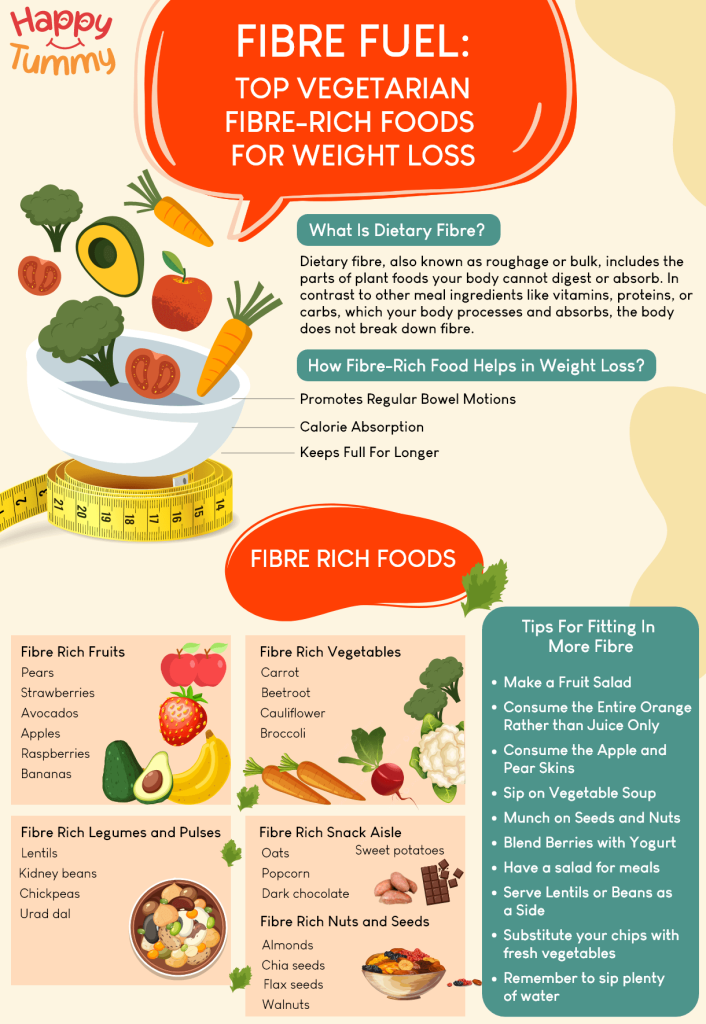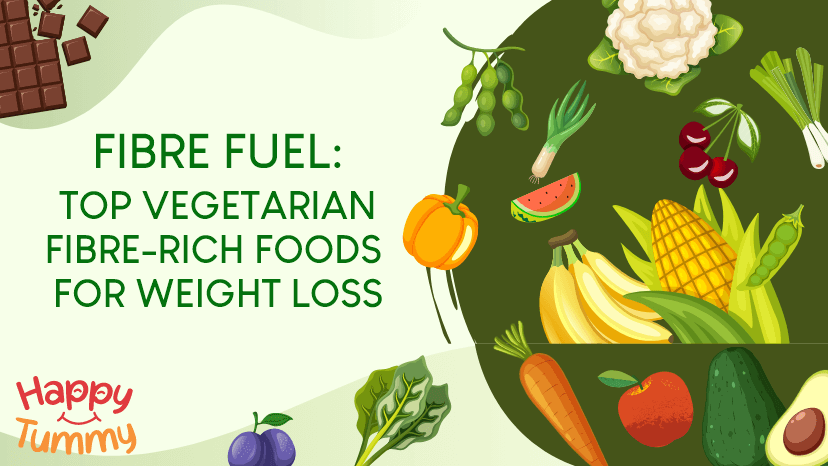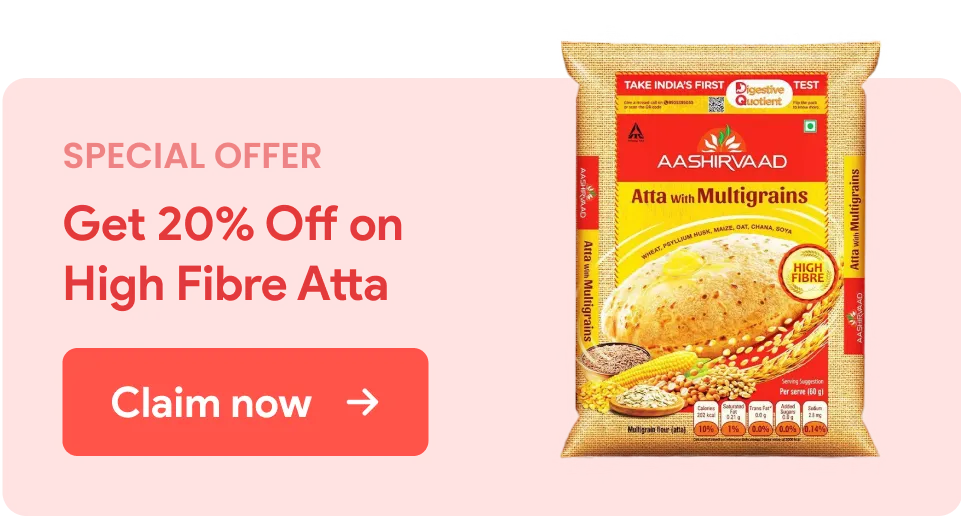Table of Contents
Many of us have personal experience with achieving and maintaining a healthy weight. There is no lack of methods to reach that goal: you may track points, calories, or carbohydrates. You may consume less sugar or fat.
You may experiment with well-known diets restricting particular foods or concentrate on just one (intermittent fasting, anyone?). Any of these strategies could be effective for you. Or they might not; this is primarily due to their complexity.
However, even a more complex diet won’t be as successful at helping you lose weight and get the nutrients you need as something as basic as trying to get 20-30 grams of fibre each day, depending on age, gender, and lifestyle. Yes, you heard it right. Your dream of managing weight and leading a healthy life may be possible by simply adding vegetarian fibre-rich foods to your diet.
Learn all there is to know about the fantastic world of fibre, including what it is, what foods are high in it, and exciting methods to include more of it into your diet for energy and improved health!
What Is Dietary Fibre?
Dietary fibre, also known as roughage or bulk, includes the parts of plant foods that bypass digestion. In contrast to other meal ingredients like vitamins, proteins, or carbs, which your body processes and absorbs, the body does not break down fibre. Instead, it exits your body through your colon, small intestine, and stomach largely intact [1].
Typically, fibre is categorized as either soluble (it dissolves in water) or insoluble (it doesn’t dissolve) [2].
- Soluble fibre: This kind of fibre becomes a gel-like substance when it dissolves in water. It may assist in lowering blood sugar and cholesterol. Oats, peas, beans, carrots, citrus fruits, apples, barley, and broccoli are high in soluble fibre.
- Insoluble fibre: Those who experience constipation or irregular stools may find this type of fibre beneficial since it facilitates the passage of material through the digestive system and increases stool volume. Insoluble fibre may be found in whole-wheat flour, wheat bran, nuts, beans, and vegetables like potatoes, green beans, and cauliflower.
The proportion of soluble and insoluble fibre in various plant diets varies. You may consume a wide range of high-fibre foods for the most health benefits.
How Fibre-Rich Food Helps in Weight Loss?
Fibre-rich foods have unique qualities that aid our digestive systems and provide several health benefits. The following is the reasoning as to how it aids in weight loss [3]:
1. Promotes Regular Bowel Motions
Dietary fibre softens your stool and makes it bulkier. Because dense stool is easier to pass, constipation is less likely. Due to its ability to absorb water and give stool volume, fibre may help firm loose, watery stools.
2. Manages Calorie Absorption and Weight
The net calories absorbed from fibre-rich foods are much lower than foods that do not contain fibre. Most processed foods, ultra-processed foods, and beverages have little to no fibre, making them easily absorbed and high in calories, which promotes obesity. High-fibre natural substitutes are great for losing weight.
3. Keeps Full For Longer, Treats Constipation
Consuming nutritious foods high in fibre promotes satiety or fullness and reduces the amount of calories consumed. Furthermore, chewing these foods rather than downing a glass of juice increases calorie burn.
Slowing down the rate at which food passes through the digestive tract, and stomach is another advantage of eating a diet high in fibre for weight loss[4]. This is another way that fibre-rich foods make us feel satisfied and less starving between meals.
In addition to adding bulk and volume and retaining more water, fibre is frequently utilized to treat constipation. Sufficient hydration facilitates this goal.
If you’re constantly searching for new methods to increase your fibre intake and finding it difficult, there is no need to panic!
Aashirvaad Atta, with Multigrains and a team of knowledgeable nutritionists, created the My Meal Plan test to calculate your daily fiber consumption and generate a meal plan that meets suggested intake guidelines.
Fibre-Rich Foods

Having talked about the meaning of fibre and how it works in the weight loss journey, it’s time now to know the foods you must consume to increase your fibre intake. Foods high in fibre may help you with weight loss. So, here is a list of foods with fibre content that will make it easy for you to eat those that will fulfill your goals [5].
| Food | Fibre Content (grams) |
| Carrots | 2.8 |
| Beets | 2 |
| Broccoli | 2.6 |
| Kale | 4.1 |
| Spinach | 2.2 |
| Tomatoes | 1.2 |
| Lentils | 10.7 |
| Kidney Beans | 7.4 |
| Chickpeas | 7.6 |
| Popcorn (air-popped) | 14.5 |
| Almonds | 13.3 |
| Chia Seeds | 34.4 |
| Fresh Coconut | 9 |
| Pistachios | 10.6 |
| Walnuts | 6.7 |
| Sunflower Seeds | 8.6 |
| Pumpkin Seeds | 6 |
| Sweet Potatoes | 3 |
| Dark Chocolate (70%-95% cocoa) | 10.9 |
| Strawberries | 2 |
| Avocado | 6.7 |
| Oats | 10.1 |
| Apples | 2.4 |
| Raspberries | 6.5 |
| Blueberries | 2.4 |
| Blackberries | 5.3 |
| Bananas | 2.6 |
Let’s discuss these foods in more detail:
Fibre-Rich Fruits
1. Pears (Nashpati) may give a sweet craving and are pleasant and healthful. They provide a large amount of fibre as well.
2. Strawberries make a tasty and healthful dessert or workplace snack. They are high in fibre, vitamin C, manganese, and other antioxidants.
3. Avocados are an excellent source of fibre and are high in heart-healthy fats. They also contain Vitamin C, potassium, magnesium, vitamin E, and several B vitamins.
4. Apples are a fulfilling and delicious fruit. They also supply soluble and insoluble fibre when you eat along with its skin. However, please make sure to wash it properly before eating, as most pesticides reside on the skin.
5. Raspberries are a tasty fruit that is high in nutrients. They are rich in manganese, fibre, and vitamin C. Blackberries and blueberries are other berries that are also strong in fibre.
6. Bananas are rich in potassium, vitamin B6, and vitamin C, among other nutrients. Additionally, a large amount of resistant starch—an indigestible carbohydrate that acts like fibre—may be found in green or unripe bananas that help support gut health, promote feelings of fullness, and may aid in blood sugar control by slowing down digestion and absorption of carbohydrates.
Fibre-Rich Vegetables
1. A carrot is a root vegetable you may eat raw or cooked. It is high in fibre, vitamin K, vitamin B6, magnesium, and beta carotene, an antioxidant that your body converts to vitamin A. Carrots’ high fibre content helps you feel full, which is suitable for managing your weight and general health.
2. Beetroot vegetables are rich in minerals like potassium, manganese, iron, and folate and contain sufficient fibres to help you lose weight. Additionally, beets include inorganic nitrates, minerals that may help control blood pressure and enhance athletic performance.
3. Cauliflower contains two grams of fibre in one cup, making it a high-fibre food. This represents 7% of the suggested daily intake. Cauliflower’s fibre supports good bacteria in the gut that lessen inflammation, which is beneficial for digestive health. It may also help you manage constipation.
4. Broccoli is a cruciferous vegetable that is high in nutrients. In addition to fibre, it includes B vitamins, potassium, iron, manganese, vitamin C, vitamin K, and folate. Antioxidants and other nutrients contained in it might aid in the battle against inflammation.
Fibre-Rich Legumes and Pulses
1. Lentils promote regular bowel motions and the development of beneficial gut flora because of their high fibre content. Consuming lentils might strengthen your digestive system and make the stool heavier.
2. Kidney beans (Rajma) are excellent in fibre. They have high levels of resistant starch, which could help with weight loss.
3. Chickpeas (Chana Dal) are high in dietary fibre, especially a soluble fibre called raffinose. Your gut’s beneficial bacteria break this down so your colon may gradually absorb it. Studies have found that chickpeas may help make bowel movements easier and more regular. They may aid in lowering cholesterol.
4. Urad dal, another name for black gram, is a food item high in dietary fibre. Thirty grams of raw black gram contains 3.5 grams of fibre, making it a great addition to your diet [6]
Fibre-Rich Fibre-Rich Snack Aisle
1. Oats are high in fibre and rich in vitamins, minerals, and antioxidants. They have a potent soluble fibre that may help manage cholesterol and blood sugar levels.
2. Popcorn is a tasty and healthful way to get more fibre. For every calorie, air-popped popcorn has a very high fibre content.
3. Sweet potatoes aid digestion, promote gut health and have a high dietary fibre content. The high fibre content of sweet potatoes may also help prevent constipation in both children and adults.
4. Dark chocolate is an excellent source of prebiotics due to its high fibre content. Prebiotics fuel the “good” bacteria in your gut to develop and thrive, preventing the bad bacteria from taking over. Increased fibre also results in better digestion and less constipation.
Fibre-Rich Nuts and Seeds
1. Almonds have a high fibre content; 23 almonds provide 14% of your daily recommended fibre consumption [7]. Both soluble and insoluble fibre found in almonds may lower cholesterol and aid with digestion.
2. Chia seeds are little black seeds that are very nutritious. Chia seeds contain about 10 grams of fibre in two tablespoons. That is about 40% of the daily allowance [8].
3. Flax seeds are high in dietary fibre because they contain a substantial amount of soluble and insoluble fibre. They are among the most excellent plant-based sources of dietary fibre since they provide roughly 27 grams of fibre per 100 grams [9].
While the insoluble fibre in flax seeds may help maintain digestive health by giving stool more volume and reducing constipation, the soluble fibre in flax seeds helps control cholesterol levels and encourages a sensation of fullness.
4. Walnuts are exceptionally high in dietary fibre and may be a natural remedy for constipation as well as a vital factor in regular bowel motions and improved digestion.
Tips For Fitting In More Fibre-Rich
You may increase the fibre in your diet by making small changes and additions to your meals. The following helpful tips may assist you in increasing your consumption of fibre:
1. Make a Fruit Salad
A fruit salad is a great way to start a meal or have it as dessert. It just needs to be a few of your favorite fruits combined with a small amount of yogurt or fruit juice for dressing. You may add a handful of nuts and seeds for even more fibre.
2. Consume the Entire Orange Rather than Juice Only
We’re not arguing against the health benefits of orange juice. It is rich in minerals and vitamins. But when you consume the entire orange, you still receive all the vitamins and minerals and a lot more fibre and sweetness. There are 3.7 grams of fibre in an orange whole. Only 0.6 grams of fibre are present in a glass of orange juice [10].
3. Consume the Apple and Pear Skins
Fruit peels may not be something picky eaters are particularly excited about. While you wouldn’t eat a banana peel or an orange rind, you may enjoy apples and pears with intact coverings. In addition to protecting the delicate flesh within, the fruit’s skin contains almost 50% of its fibre.
4. Sip on Vegetable Soup
Vegetable soups may have a lot of fibre. To increase your soup’s fibre content and nutritional value, simply add some freshly chopped or frozen vegetables and let them cook until they become soft. Potatoes, peas, and carrots are all excellent options.
Pro Tip: Whenever possible, adopt low-sodium stews and soups
5. Munch on Seeds and Nuts
Nuts are an excellent source of fibre, protein, and healthy fats. Examples include walnuts, flax seeds, chia seeds, almonds, and cashews. These are ideal as a mid-afternoon snack to sustain you until dinnertime.
6. Blend Berries with Yogurt
Mix in berries to add fibre to yoghurt. Yoghurt is an excellent source of protein, calcium, and good bacteria. Serve a superfood dessert by adding blueberries, raspberries, or strawberries to a silky smooth yoghurt. For extra fibre, mix in some muesli or nuts. For a bit of sweetness, drizzle with a little honey.
7. Have a salad for meals
Eating a salad substantial enough to be a meal is one of the favorite methods to increase fibre and reduce calories. Begin with a bed of savoury vegetables, like spinach, carrots, or cucumbers. For some plant-based protein, add chickpeas or white beans; for some healthy fat, add avocado, almonds, or seeds. Add a small amount of vinaigrette on top. Add some cooked shrimp, chicken, or salmon on top if you think you need additional protein.
8. Serve Lentils or Beans as a Side
Legumes are incredibly high in dietary fibre. Having beans or lentils for lunch or dinner significantly increases your fibre intake right away. 8.3 grams of fibre are found in a half cup of black beans, while more than 8 grams are found in a half cup of lentils. Yes, and canned beans are also acceptable. Just give them a quick washing before cooking.
9. Substitute your chips with fresh vegetables
A typical snack for gatherings or binge-watching your preferred TV series is chips and dip. However, since they are typically poor in fibre and rich in fat, swap the chips with crisp, fresh vegetables. Excellent vegetable dippers are sliced peppers, carrot sticks, celery, and cucumbers.
10. Remember to sip plenty of water
A high-fibre diet might not prevent or manage constipation if you don’t drink enough water each day. A serving of some really high-fibre breakfast cereals may contain about 10g of fibre. This cereal could make you feel dizzy or constipated if you don’t drink enough water with it.
The Last Say
You may shed some pounds and maintain good cholesterol levels by incorporating these high-fibre foods into your regular meals. Don’t forget to progressively up your fibre intake to avoid experiencing any discomfort in your digestive system.
Aim for 25–30 grams of fibre per day, which may be obtained from various foods, including whole grains, legumes, nuts, seeds, and fruits.
A high-fibre diet doesn’t have to be complicated or boring to incorporate. Try a variety of meals that include these high-fibre foods: serve your main dish with a side of sautéed vegetables in nut butter, or add steamed or baked chickpeas to salads. You may even make a fibre-rich smoothie with berries and oats.
You may simply boost your fibre consumption with a little forethought and imagination. So get started now and enjoy the advantages of a fibre-rich diet!
FAQs
A. Hunger after meals, bloating, and constipation may result from a low-fibre diet. Inflammation, fatigue, wounds, elevated cholesterol, weight gain, and unstable blood sugar levels are some more symptoms. In addition, a diet deficient in fibre raises the chance of developing conditions such as heart disease, type 2 diabetes, irritable bowel syndrome (IBS), obesity, and overweight.
Chickpeas, lentils, broccoli, oats, apples, pears, almonds, chia seeds, carrots, and avocado are a few excellent additions to the diet. But it’s critical to maintain a balance of nutrients in your diet.
Yes, deficits in certain nutrients may result from a lack of fibre. In fact, studies reveal a correlation between low intakes of fibre and poor intakes of vital nutrients such as vitamins A, C, and E. Thus, make sure to eat a diet high in fibre-rich foods.
The American Heart Association Eating Plan advises consuming a range of dietary sources of fiber. Aim for a daily total of 25 to 30 grams of dietary fiber from food—not supplements [11].
Yes, for those with restricted diets, there are other forms of fibre. Fruits, chia seeds, flaxseeds, pumpkin seeds, psyllium husk, and veggies like carrots and broccoli are a few options. It is highly recommended that you adhere to a plant-based, well-balanced diet that focuses on whole foods to eat a plentiful and healthful diet. Additionally, you may book an online consultation with our certified nutritionist for dietary and nutritional guidance.















